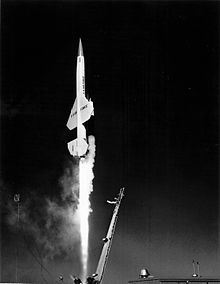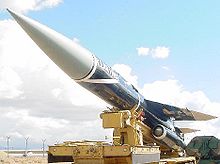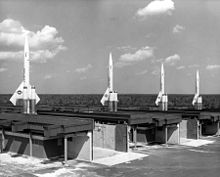
CIM-10 Bomarc

| CIM-10 Bomarc | |
|---|---|
 | |
| Type | Surface-to-air missile |
| Place of origin | United States |
| Service history | |
| In service | 1959 to 1 October 1972[2] |
| Used by | United States Air Force Royal Canadian Air Force Canadian Forces |
| Production history | |
| Manufacturer | Boeing Pilotless Aircraft Division[3] |
| Produced | 1958 |
| Specifications | |
| Diameter | 35 in (890 mm) |
| Wingspan | 218.2 in (5,540 mm) |
| Warhead | W40 nuclear warhead |
| Engine |
|
| Flight ceiling | 100,000 ft (30,000 m) |
Guidance system | Initially ground-controlled, active radar homing terminal guidance |

The Boeing CIM-10 Bomarc ("Boeing Michigan Aeronautical Research Center") (IM-99 Weapon System[4] prior to September 1962)[5][6] was a supersonic ramjet powered long-range surface-to-air missile (SAM) used during the Cold War for the air defense of North America. In addition to being the first operational long-range SAM and the first operational pulse doppler aviation radar,[7] it was the only SAM deployed by the United States Air Force.

Stored horizontally in a launcher shelter with a movable roof, the missile was erected, fired vertically using rocket boosters to high altitude, and then tipped over into a horizontal Mach 2.5 cruise powered by ramjet engines. This lofted trajectory allowed the missile to operate at a maximum range as great as 430 mi (690 km). Controlled from the ground for most of its flight, when it reached the target area it was commanded to begin a dive, activating an onboard active radar homing seeker for terminal guidance. A radar proximity fuse detonated the warhead, either a large conventional explosive or the W40 nuclear warhead.

The Air Force originally planned for a total of 52 sites covering most of the major cities and industrial regions in the US. The United States Army was deploying their own systems at the same time, and the two services fought constantly both in political circles and in the press. Development dragged on, and by the time it was ready for deployment in the late 1950s, the nuclear threat had moved from manned bombers to the intercontinental ballistic missile (ICBM). By this time the Army had successfully deployed the much shorter range Nike Hercules that they claimed filled any possible need through the 1960s, in spite of Air Force claims to the contrary.[8]

As testing continued, the Air Force reduced its plans to sixteen sites, and then again to eight with an additional two sites in Canada. The first US site was declared operational in 1959, but with only a single working missile. Bringing the rest of the missiles into service took years, by which time the system was obsolete. Deactivations began in 1969 and by 1972 all Bomarc sites had been shut down. A small number were used as target drones, and only a few remain on display today.

Design and development
Initial studies
During World War II, the US Army Air Force (USAAF) concluded that existing anti-aircraft guns, only marginally effective against existing generations of propeller-driven aircraft, would not be effective at all against the emerging jet-powered designs. Like the Germans and British before them, they concluded the only successful defence would be to use guided weapons.[9]

As early as 1944 the United States Army started exploring anti-aircraft missiles, examining a variety of concepts. At the time, two basic concepts appeared possible; one would use a short-range rocket that flew directly at the target from below following a course close to the line-of-sight, and the other would fly up to the target's altitude and then tip over and fly horizontally towards the target like a fighter aircraft. As both concepts seemed promising, the Army Air Force was given the task of developing the airplane-like design, while the Army Ordnance Department was given the more ballistic collision-course concept. Official requirements were published in 1945.[10]

Official requirements were published in 1945; Bell Laboratories won the Ordnance contract for a short-range line-of-sight weapon under Project Nike,[9] while a team of players led by Boeing won the contract for a long-range design known as Ground-to-Air Pilotless Aircraft, or GAPA. GAPA moved to the United States Air Force when that branch was formed in 1947. In 1946, the USAAF also started two early research projects into anti-missile systems in Project Thumper (MX-795) and Project Wizard (MX-794).[11]

Bomarc A
Formally organized in 1946 under USAAF project MX-606, by 1950 Boeing had launched more than 100 test rockets in various configurations, all under the designator XSAM-A-1 GAPA. The tests were very promising, and Boeing received a USAF contract in 1949 to develop a production design under project MX-1599.[12]

The MX-1599 missile was to be a ramjet-powered, nuclear-armed long-range surface-to-air missile to defend the Continental United States from high-flying bombers. The Michigan Aerospace Research Center (MARC) was added to the project soon afterward, and this gave the new missile its name Bomarc (for Boeing and MARC). In 1951, the USAF decided to emphasize its point of view that missiles were nothing else than pilotless aircraft by assigning aircraft designators to its missile projects, and anti-aircraft missiles received F-for-Fighter designations.[clarification needed] The Bomarc became the F-99.[12]

By this time, the Army's Nike project was progressing well and would enter operational service in 1953. This led the Air Force to begin a lengthy series of attacks on the Army in the press, a common occurrence at the time known as "policy by press release". When the Army released its first official information on Ajax to the press, the Air Force responded by leaking information on BOMARC to Aviation Week,[13] and continued to denigrate Nike in the press over the next few years, in one case showing a graphic of Washington being destroyed by nuclear bombs that Ajax failed to stop.[14]

Tests of the XF-99 test vehicles began in September 1952 and continued through early 1955.[15] The XF-99 tested only the liquid-fueled booster rocket, which would accelerate the missile to ramjet ignition speed. In February 1955, tests of the XF-99A propulsion test vehicles began. These included live ramjets, but still had no guidance system or warhead. The designation YF-99A had been reserved for the operational test vehicles. In August 1955, the USAF discontinued the use of aircraft-like type designators for missiles, and the XF-99A and YF-99A became XIM-99A and YIM-99A, respectively. Originally the USAF had allocated the designation IM-69, but this was changed (possibly at Boeing's request to keep number 99) to IM-99 in October 1955.

By this time, Ajax was widely deployed around the United States and some overseas locations, and the Army was beginning to develop its much more powerful successor, Nike Hercules. Hercules was an existential threat to BOMARC, as its much greater range and nuclear warhead filled many of the roles that BOMARC was designed for. A new round of fighting in the press broke out, capped by an article in The New York Times entitled "Air Force Calls Army Nike Unfit To Guard Nation".[16]

In October 1957, the first YIM-99A production-representative prototype flew with full guidance, and succeeded to pass the target within destructive range. In late 1957, Boeing received the production contract for the IM-99A Bomarc A, and in September 1959, the first IM-99A squadron became operational.[12]

The IM-99A had an operational radius of 200 miles (320 km) and was designed to fly at Mach 2.5–2.8 at a cruising altitude of 60,000 feet (18,000 m). It was 46.6 ft (14.2 m) long and weighed 15,500 pounds (7,000 kg). Its armament was either a 1,000-pound (450 kg) conventional warhead or a W40 nuclear warhead (7–10 kiloton yield). A liquid-fuel rocket engine boosted the Bomarc to Mach 2, when its Marquardt RJ43-MA-3 ramjet engines, fueled by 80-octane gasoline, would take over for the remainder of the flight. This was the same model of engine used to power the Lockheed X-7, the Lockheed AQM-60 Kingfisher drone used to test air defenses, and the Lockheed D-21 launched from the back of an M-21, although the Bomarc and Kingfisher engines used different materials due to the longer duration of their flights.[12]

Operational units

The operational IM-99A missiles were based horizontally in semi-hardened shelters, nicknamed "coffins". After the launch order, the shelter's roof would slide open, and the missile raised to the vertical. After the missile was supplied with fuel for the booster rocket, it would be launched by the Aerojet General LR59-AJ-13 booster. After sufficient speed was reached, the Marquardt RJ43-MA-3 ramjets would ignite and propel the missile to its cruise speed of Mach 2.8 at an altitude of 66,000 ft (20,000 m).[12]

When the Bomarc was within 10 mi (16 km) of the target, its own Westinghouse AN/DPN-34 radar guided the missile to the interception point. The maximum range of the IM-99A was 250 mi (400 km), and it was fitted with either a conventional high-explosive or a 10 kiloton W-40 nuclear fission warhead.[12]

The Bomarc relied on the Semi-Automatic Ground Environment (SAGE), an automated control system used by NORAD for detecting, tracking and intercepting enemy bomber aircraft. SAGE allowed for remote launching of the Bomarc missiles, which were housed in a constant combat-ready basis in individual launch shelters in remote areas. At the height of the program, there were 14 Bomarc sites located in the US and two in Canada.[12]

Bomarc B
The liquid-fuel booster of the Bomarc A had several drawbacks. It took two minutes to fuel before launch, which could be a long time in high-speed intercepts, and its hypergolic propellants (hydrazine and nitric acid) were very dangerous to handle, leading to several serious accidents.[12]

As soon as high-thrust solid-fuel rockets became a reality in the mid-1950s, the USAF began to develop a new solid-fueled Bomarc variant, the IM-99B Bomarc B. It used a Thiokol XM51 booster, and also had improved Marquardt RJ43-MA-7 (and finally the RJ43-MA-11) ramjets. The first IM-99B was launched in May 1959, but problems with the new propulsion system delayed the first fully successful flight until July 1960, when a supersonic MQM-15A Regulus II drone was intercepted. Because the new booster required less space in the missile, more ramjet fuel could be carried, thus increasing the range to 430 mi (700 km). The terminal homing system was also improved, using the world's first pulse Doppler search radar, the Westinghouse AN/DPN-53.[7] All Bomarc Bs were equipped with the W-40 nuclear warhead. In June 1961, the first IM-99B squadron became operational, and Bomarc B quickly replaced most Bomarc A missiles.[12] On 23 March 1961, a Bomarc B successfully intercepted a Regulus II cruise missile flying at 100,000 ft (30,000 m), thus achieving the highest interception in the world up to that date.

Boeing built 570 Bomarc missiles between 1957 and 1964, 269 CIM-10A, 301 CIM-10B.[12]


In September 1958 Air Research & Development Command decided to transfer the Bomarc program from its testing at Cape Canaveral Air Force Station to a new facility on Santa Rosa Island, south of Eglin AFB Hurlburt Field on the Gulf of Mexico. To operate the facility and to provide training and operational evaluation in the missile program, Air Defense Command established the 4751st Air Defense Wing (Missile) (4751st ADW) on 15 January 1958. The first launch from Santa Rosa took place on 15 January 1959.[12]

Operational history
In 1955, to support a program which called for 40 squadrons of BOMARC (120 missiles to a squadron for a total of 4,800 missiles), ADC reached a decision on the location of these 40 squadrons and suggested operational dates for each. The sequence was as follows: ... l. McGuire 1/60 2. Suffolk 2/60 3. Otis 3/60 4. Dow 4/60 5. Niagara Falls 1/61 6. Plattsburgh 1/61 7. Kinross 2/61 8. K.I. Sawyer 2/61 9. Langley 2/61 10. Truax 3/61 11. Paine 3/61 12. Portland 3/61 ... At the end of 1958, ADC plans called for construction of the following BOMARC bases in the following order: l. McGuire 2. Suffolk 3. Otis 4. Dow 5. Langley 6. Truax 7. Kinross 8. Duluth 9. Ethan Allen 10. Niagara Falls 11. Paine 12. Adair 13. Travis 14. Vandenberg 15. San Diego 16. Malmstrom 17. Grand Forks 18. Minot 19. Youngstown 20. Seymour-Johnson 21. Bunker Hill 22. Sioux Falls 23. Charleston 24. McConnell 25. Holloman 26. McCoy 27. Amarillo 28. Barksdale 29. Williams.[17]

United States
The first USAF operational Bomarc squadron was the 46th Air Defense Missile Squadron (ADMS), organized on 1 January 1959 and activated on 25 March. The 46th ADMS was assigned to the New York Air Defense Sector at McGuire Air Force Base, New Jersey. The training program, under the 4751st Air Defense Wing used technicians acting as instructors and was established for a four-month duration. Training included missile maintenance; SAGE operations and launch procedures, including the launch of an unarmed missile at Eglin. In September 1959 the squadron assembled at their permanent station, the Bomarc site near McGuire AFB, and trained for operational readiness. The first Bomarc-A were used at McGuire on 19 September 1959 with Kincheloe AFB getting the first operational IM-99Bs. While several of the squadrons replicated earlier fighter interceptor unit numbers, they were all new organizations with no previous historical counterpart.[18][19]

ADC's initial plans called for some 52 Bomarc sites around the United States with 120 missiles each but as defense budgets decreased during the 1950s the number of sites dropped substantially. Ongoing development and reliability problems didn't help, nor did Congressional debate over the missile's usefulness and necessity. In June 1959, the Air Force authorized 16 Bomarc sites with 56 missiles each; the initial five would get the IM-99A with the remainder getting the IM-99B. However, in March 1960, HQ USAF cut deployment to eight sites in the United States and two in Canada.[12]

Bomarc incident
Within a year of operations, a Bomarc A with a nuclear warhead caught fire at McGuire AFB on 7 June 1960 after its on-board helium tank exploded. While the missile's explosives did not detonate, the heat melted the warhead and released plutonium, which the fire crews spread. The Air Force and the Atomic Energy Commission cleaned up the site and covered it with concrete. This was the only major incident involving the weapon system.[12] The site remained in operation for several years following the fire. Since its closure in 1972, the area has remained off limits, primarily due to low levels of plutonium contamination.[20] Between 2002 and 2004, 21,998 cubic yards of contaminated debris and soils were shipped to what was then known as Envirocare, located in Utah.[21]

Modification and deactivation
In 1962, the US Air Force started using modified A-models as drones; following the October 1962 tri-service redesignation of aircraft and weapons systems they became CQM-10As. Otherwise the air defense missile squadrons maintained alert while making regular trips to Santa Rosa Island for training and firing practice. After the inactivation of the 4751st ADW(M) on 1 July 1962 and transfer of Hurlburt to Tactical Air Command for air commando operations the 4751st Air Defense Squadron (Missile) remained at Hurlburt and Santa Rosa Island for training purposes.[12]

In 1964, the liquid-fueled Bomarc-A sites and squadrons began to be deactivated. The sites at Dow and Suffolk County closed first. The remainder continued to be operational for several more years while the government started dismantling the air defense missile network. Niagara Falls was the first BOMARC B installation to close, in December 1969; the others remained on alert through 1972. In April 1972, the last Bomarc B in U.S. Air Force service was retired at McGuire and the 46th ADMS inactivated[12] and the base was deactivated.[22]


In the era of the intercontinental ballistic missiles the Bomarc, designed to intercept relatively slow manned bombers, had become a useless asset. The remaining Bomarc missiles were used by all armed services as high-speed target drones for tests of other air-defense missiles. The Bomarc A and Bomarc B targets were designated as CQM-10A and CQM-10B, respectively.[12]

Following the accident, the McGuire complex has never been sold or converted to other uses and remains in Air Force ownership, making it the most intact site of the eight in the US. It has been nominated to the National Register of Historic Sites. Although a number of IM-99/CIM-10 Bomarcs have been placed on public display, because of concerns about the possible environmental hazards of the thoriated magnesium structure of the airframe several have been removed from public view.[23]

Russ Sneddon, director of the Air Force Armament Museum, Eglin Air Force Base, Florida provided information about missing CIM-10 exhibit airframe serial 59–2016, one of the museum's original artifacts from its founding in 1975 and donated by the 4751st Air Defense Squadron at Hurlburt Field, Eglin Auxiliary Field 9, Eglin AFB. As of December 2006, the suspect missile was stored in a secure compound behind the Armaments Museum. In December 2010, the airframe was still on premises, but partly dismantled.[citation needed]

Canada
The Bomarc Missile Program was highly controversial in Canada.[24] The Progressive Conservative government of Prime Minister John Diefenbaker initially agreed to deploy the missiles, and shortly thereafter controversially scrapped the Avro Arrow, a supersonic manned interceptor aircraft, arguing that the missile program made the Arrow unnecessary.[24]

Initially, it was unclear whether the missiles would be equipped with nuclear warheads. By 1960 it became known that the missiles were to have a nuclear payload, and a debate ensued about whether Canada should accept nuclear weapons.[25] Ultimately, the Diefenbaker government decided that the Bomarcs should not be equipped with nuclear warheads.[26] The dispute split the Diefenbaker Cabinet, and led to the collapse of the government in 1963.[26] The Official Opposition and Liberal Party leader Lester B. Pearson originally was against nuclear missiles, but reversed his personal position and argued in favour of accepting nuclear warheads.[27] He won the 1963 election, largely on the basis of this issue, and his new Liberal government proceeded to accept nuclear-armed Bomarcs, with the first being deployed on 31 December 1963.[28] When the nuclear warheads were deployed, Pearson's wife, Maryon, resigned her honorary membership in the anti-nuclear weapons group, Voice of Women.[25]

Canadian operational deployment of the Bomarc involved the formation of two specialized Surface/Air Missile squadrons. The first to begin operations was No. 446 SAM Squadron at RCAF Station North Bay, which was the command and control center for both squadrons.[28] With construction of the compound and related facilities completed in 1961, the squadron received its Bomarcs in 1961, without nuclear warheads.[28] The squadron became fully operational from 31 December 1963, when the nuclear warheads arrived, until disbanding on 31 March 1972. All the warheads were stored separately and under control of Detachment 1 of the USAF 425th Munitions Maintenance Squadron at Stewart Air Force Base. During operational service, the Bomarcs were maintained on stand-by, on a 24-hour basis, but were never fired, although the squadron test-fired the missiles at Eglin AFB, Florida on annual winter retreats.[29]

No. 447 SAM Squadron operating out of RCAF Station La Macaza, Quebec, was activated on 15 September 1962 although warheads were not delivered until late 1963. The squadron followed the same operational procedures as No. 446, its sister squadron. With the passage of time the operational capability of the 1950s-era Bomarc system no longer met modern requirements; the Department of National Defence deemed that the Bomarc missile defense was no longer a viable system, and ordered both squadrons to be stood down in 1972. The bunkers and ancillary facilities remain at both former sites.[30]

Variants

- XF-99 (experimental for booster research)
- XF-99A/XIM-99A (experimental for ramjet research)
- YF-99A/YIM-99A[31] (service-test)
- IM-99A/CIM-10A (initial production)
- IM-99B/CIM-10B ("advanced"[32])
- CQM-10A (target drone developed from CIM-10A)[33]
- CQM-10B (target drone developed from CIM-10B)[33]
Operators
 /
/  Canada
Canada
- Royal Canadian Air Force from 1955 to 1968 / Canadian Forces from 1968 to 1972
- 446 SAM Squadron: 28 IM-99B, CFB North Bay, Ontario 1962–1972[29][34]
- Bomarc site located at 46°25′46″N 079°28′16″W / 46.42944°N 79.47111°W
- 447 SAM Squadron: 28 IM-99B, La Macaza, Quebec (La Macaza – Mont Tremblant International Airport) 1962–1972[30][35]
- Bomarc site located at 46°24′41″N 074°46′08″W / 46.41139°N 74.76889°W (Approximately)
|
|
- Cape Canaveral Air Force Station, Florida
- Launch Complex 4 (LC-4) was used for Bomarc testing and development launches 2 February 1956 – 15 April 1960 (17 Launches). 28°27′59″N 080°32′08″W / 28.46639°N 80.53556°W
- Vandenberg Air Force Base, California
- Two launch sites, BOM-1 and BOM-2 were used by the United States Navy for Bomarc launches against aerial targets. The first launch taking place on 25 August 1966. The last two launches occurred on 14 July 1982. BOM1 49 launches; BOM2 38 launches. 34°48′02″N 120°35′57″W / 34.80056°N 120.59917°W
- Cape Canaveral Air Force Station, Florida
Locations under construction but not activated. Each site was programmed for 28 IM-99B missiles:

- Camp Adair, Oregon 44°42′08″N 123°12′00″W / 44.70222°N 123.20000°W
- Charleston AFB, South Carolina
- Ethan Allen AFB, Vermont 44°30′38″N 073°09′49″W / 44.51056°N 73.16361°W
- Paine Field, Washington 47°54′43″N 122°15′55″W / 47.91194°N 122.26528°W
- Travis AFB, California 38°29′14″N 121°53′07″W / 38.48722°N 121.88528°W
- Truax Field, Wisconsin 43°11′27″N 089°09′15″W / 43.19083°N 89.15417°W
- Vandenberg AFB, California 34°43′47″N 120°30′15″W / 34.72972°N 120.50417°W
Reference for BOMARC units and locations:[36]

-
6th ADMS
-
22d ADMS
-
26th ADMS
-
30th ADMS
-
35th ADMS
-
37th ADMS
-
46th ADMS
-
74th ADMS
-
4751st ADMS
-
RCAF 446 Sqdn
-
RCAF 447 Squdn
Surviving missiles

Below is a list of museums or sites which have a Bomarc missile on display:

- Air Force Armament Museum, Eglin Air Force Base, Florida
- Air Force Space & Missile Museum, Cape Canaveral Air Force Station, Florida. It is on display Hangar C.
- Alberta Aviation Museum, Edmonton, Alberta, Canada
- Canada Aviation and Space Museum, Ottawa, Ontario, Canada
- Hill Aerospace Museum, Hill Air Force Base, Utah
- Historical Electronics Museum, Linthicum, Maryland (display of AN/DPN-53, the first airborne pulse-doppler radar, used in the Bomarc)
- Illinois Soldiers & Sailors Home, Quincy, Illinois
- Keesler Air Force Base, Biloxi, Mississippi
- Museum of Aviation, Robins Air Force Base, Warner Robins, Georgia
- National Museum of Nuclear Science & History, Kirtland Air Force Base, Albuquerque, New Mexico
- Octave Chanute Aerospace Museum (former Chanute Air Force Base), Rantoul, Illinois; the museum closed on 30 December 2015
- Peterson Air and Space Museum, Peterson Air Force Base, Colorado
- Strategic Air and Space Museum, Ashland, Nebraska
- USAF Airman Heritage Museum, Lackland Air Force Base, San Antonio, Texas
- Vandenberg Air Force Base (Space and Missile Heritage Center), California. Bomarc not for public access.
Impact on popular music
The Bomarc missile captured the imagination of the American and Canadian popular music industry, giving rise to a pop music group, the Bomarcs (composed mainly of servicemen stationed on a Florida radar site that tracked Bomarcs),[37][38] a record label, Bomarc Records,[39][40] and a moderately successful Canadian pop group, The Beau Marks.

See also
Aircraft of comparable role, configuration, and era

- Blue Envoy, UK system of very similar performance, cancelled in 1957 in favor of the Bristol Bloodhound.

References
- ^ The SAGE/Bomarc Air Defense Weapons System: An Illustrated Explanation of What it is and How it Works (fact sheet) (Report). New York: International Business Machines Corporation. 1959. Retrieved 23 April 2013.
BOMARC Crew training was activated January 1, 1958. The operator requests an "engagement prediction point" from the IBM computer. Missile guidance information is relayed via leased lines to Cape Canaveral, and via radio to the BOMARC missile. AN/FPS-20 long-range search radar at Patrick Air Force Base
Alt URL (cited by History of Strategic Air and Ballistic Missile Defense: Volume I, p. 257.) - ^ Lombardi, Michael. "Reach for the sky" (PDF). Boeing Frontiers. Archived (PDF) from the original on 20 October 2011. Retrieved 3 November 2018.
- ^ BOMARC: Boeing's Long-range A.A. Missile (PDF), FlightGlobal, 24 May 1957, p. 687, archived (PDF) from the original on 9 October 2022, retrieved 4 August 2013,
Development of the electronic guidance was assisted by simulated IM-99 nose sections, pressurized by nitrogen and cooled by ammonia, fitted to a T-33 and a B-57, the pilot of these aircraft cutting out the guidance and breaking away from the collision course as the target was neared. … 70 per cent subcontracted: prime contractor, Boeing (assembly of missiles at the main Seattle plant, Pilotless Aircraft Division); cruise propulsion, Marquardt; boost propulsion, Aerojet-General; guidance and control, Westinghouse Air Arm Division; ground control gear, Westinghouse Electronics Division; ground-support and test gear, Farnsworth Division of I.T. and T.; airborne electronic intelligence, Lear (LearCal and Grand Rapids Divisions); nose of missile, Pastushin (glass fibre, leaves radar beams undistorted).
- ^ IM-99 Weapon System: 26 October – 28 November 1958 (PDF) (Report). 17 December 1958. Archived from the original (PDF) on 18 February 2013. Retrieved 4 August 2013.
technical training facility at Eglin Air Force Auxiliary Field Number 9. The IM-99A and IM-99B warheads (W-40) The IM-99B had been designed to include a "Pattern Patrol" type operation. Missiles could be launched in multiples, or at very close intervals and guided in a line abreast type formation with target seekers operating in search mode. This would provide a capability to patrol a given area where targets were suspected but where definite tracks had not been established.
- ^ Wragg, David W. (1973). A Dictionary of Aviation (first ed.). Osprey. p. 69. ISBN 9780850451634.
- ^ Baugher, Joe. "Boeing/MARC F-99". JoeBaugher.com. Retrieved 4 August 2013.
- ^ a b Tactical missile aerodynamics, Volume 141. P17. Michael J. Hemsch, American Institute of Aeronautics and Astronautics. American Institute of Aeronautics and Astronautics, 1992
- ^ Tactical missile aerodynamics, Volume 141. Michael J. Hemsch, American Institute of Aeronautics and Astronautics. American Institute of Aeronautics and Astronautics, 1992
- ^ a b Zeus 1962, p. 165.
- ^ Walker & Bernstein 2005, p. 39.
- ^ Walker & Bernstein 2005, p. 20.
- ^ a b c d e f g h i j k l m n o p Gibson 1996, pp. 200–201.
- ^ Aviation Week, 6 April 1953, p. 15.
- ^ "Will NIKE Protect Us from Red Bombers?". Popular Science. Vol. 169, no. 3. 1 September 1956. pp. 152–155. ISSN 0161-7370. OCLC 488612811. Retrieved 18 February 2021.
- ^ McMullen, R. F. (15 February 1980). History of Air Defense Weapons 1946–1962 (Report). Vol. ADC Historical Study No. 14. Historical Division, Office of information, HQ ADC. p. 312.
Development of a long-range interceptor missile to be known as BOMARC was approved by the Research and Development Board of the Department of Defense in December 1950. BOMARC flight testing got off to a shaky start on 10 September 1952 when the first missile was launched from the Florida test center that later became known as Cape Canaveral. …the BOMARC Weapons System Project Officer (WSPO), an ARDC official, gave permission for the launching of 12 YIM-99A (the "Y" designated experimental missiles). The first attempt at SAGE control of BOMARC occurred 7 August 1958… Because of split radar returns, SAGE was not able to give the missile the proper commands and [then a] GPA-35 took control. The missile malfunctioned, however, and [crashed] into the Atlantic. Air Force Missile Employment Facility at Hurlburt Field, Florida, Hurlburt (officially designated Eglin Auxiliary Field No. 9) [with launchers] was on a narrow strip of sand known as Santa Rosa Island. In August 1960, the BOMARC Weapons System Project Office (AMC) had assured the BOMARC General Officers Board that $100,000 would be available to pay for Boeing help. "Bomarc Alternate Boost Program at React ion Motors, Inc.," 3 July 1953 … Msg, WWXDBE-FA 18-5-47, IM-99 Field Test Sec to USAF, 19 May 1960 [Doc 304 to Hist of ADC, Jan–Jun 1960].
- ^ "Air Force Calls Army Unfit to Guard Nation". The New York Times. 21 May 1956. p. 1.
- ^ McMullen, R. F. (15 February 1980). History of Air Defense Weapons 1946–1962 (Report). Vol. ADC Historical Study No. 14. Historical Division, Office of information, HQ ADC. p. 176.
- ^ "46th Air Defense Missile Squadron." Archived 5 September 2017 at the Wayback Machine NYADS 1960 Yearbook. Retrieved 28 September 2010.
- ^ Preface by Buss, L. H. (Director) (1 May 1960). North American Air Defense Command and Continental Air Defense Command Historical Summary: July–December 1959 (PDF) (Report). Directorate of Command History: Office of Information Services. "On 7 October 1959, NORAD provided guidance on this to ADC as follows. Gap fillers will be redeployed to provide low altitude coverage (500 feet) 230 nautical Jl1il~s forward and 150 miles to the rear of all BOMARC launch sites … Criteria for BOMARC coverage is that no lateral gaps exceed 25 nautical miles (normal terrain) at a curve of constant altitude of 300 feet… Directional antennas and high power amplifiers tor the ground-to-air transmitter sites will be programmed and deployed only as required to support BOMARC operations. NORAO Objective Plan 1961–1965 … called for an F-101 squadron for Comox AB, Canada, and a BOMARC squadron for Paine AFB, Washington. To control these squadrons, NORAD also provided for an AN/FPS-28 for the Queen Charlotte Islands. … total off-shore coverage, available from ALRI and land-based sources, would permit use of the BOMARC B only to approximately 70 per cent of its low-altitude and 50 per cent of its high-altitude range capability. In the last six months of 1959. two IM-99A squadrons became operational and assumed an air defense role. The first was the 46th Air Defense Missile Squadron (BOMARC) based at McGuire AFB, New Jersey…activated on 1 January 1959, operational on 1 September 1959 with three missiles. …the 6th Air Defense Missile Squadron (BOMARC) at Suffolk 6th ADMS activated on 1 February 1959, operational on 1 December 1959. As of 1 January 1960. the McGuire squadron had 24 IM-39A missiles and the Suffolk squadron had four missiles available for air defense. The 26th ADMS, activated at Otis AFB, Massachusetts, on 1 March 1359; the 30th ADMS, activated on 1 June 1959 at Dow AFB. Maine; and the 22nd ADMS, activated on 1 September 1959 at Langley AFB, Virginia. These units were expected to become operational in 1960. NADOP 1959–1963, dated 16 December 1958 [planned for] FY 1963 of 36 IM-99B sites and 2,772 launchers. [32] in the U. S. (excluding Alaska), two in the [Alaska] 64th Air Div1sion area, and two in Canada. In March 1960, the JCS told NORAD that they were considering reducing the BOMARC program to eight U.S. and two Canadian squadrons."
- ^ Gambardello, Joseph A. "Plutonium Spill Neither Gone Nor Forgotten, 40 Years Later." The Philadelphia Inquirer, 1 June 2000, p. A01. Retrieved: 26 December 2009.
- ^ Rademacher; et al. (28 August 2007). …Missile Shelters and Bunkers Scoping Survey Workplan (Report). Vol. ADA471460. Air Force Institute of Operational Health. Archived from the original on 12 August 2013. Retrieved 9 December 2018.
- ^ THOMAS P. FARNER (23 July 2015). "Nuclear 'Cleanup' Leaves Many Questions". The Sand Paper (NJ). Retrieved 26 July 2015.
- ^ Young, Gord. "Cold War relic on the move." North Bay Nugget, 12 September 2009. Retrieved: 24 December 2009.
- ^ a b Buteux, Paul. "Bomarc Missile Crisis". The Canadian Encyclopedia. Toronto: Historica Foundation, 2012. Archived from the original on 21 January 2013. Retrieved 11 August 2012.
- ^ a b CBC Digital Archives. "Voice of Women protest nuclear testing". CBC News, 26 March 2012. Toronto. Archived from the original on 3 November 2013. Retrieved 11 August 2012.
- ^ a b "The Nuclear Question in Canada (1957–1963)". Diefenbaker Canada Centre. Regina, Saskatchewan: University of Saskatchewan. Archived from the original on 20 April 2012. Retrieved 11 August 2012.
- ^ "Cold War Canada: The Voice of Women". Canada: A People's History, 2001. Toronto: CBC. Archived from the original on 2 January 2012. Retrieved 11 August 2012.
- ^ a b c "Special to The Star: Canada's Bomarcs get atom warheads." The Toronto Daily Star, 2 January 1964, pp. 1, 4.
- ^ a b Nicks et al. 1997, pp. 84–85.
- ^ a b Nicks et al. 1997, pp. 85–87.
- ^ "Bomarc". Encyclopedia Astronautica. Archived from the original on 17 August 2013. Retrieved 7 August 2013.
Promising [GAPA] results led to Boeing receiving a USAF contract in 1949 to develop the exotic MX-1599 ramjet-powered, nuclear-armed long-range surface-to-air missile for defense of the continental United States from high-altitude bombers. The last Bomarc A was phased out in December 1964. In April 1972 the last Bomarc B was retired. Test flights of XF-99 test vehicles began in September 1952 and continued through early 1955. The XF-99 tested only the liquid-fueled booster rocket, which would accelerate the missile to ramjet ignition speed. In February 1955, tests of the XF-99A propulsion test vehicles began. These included live ramjets, but still had no guidance system or warhead. The designation YF-99A had been reserved for the operational test vehicles. In August 1955, the USAF discontinued the use of aircraft-like type designators for missiles, and the XF-99A and YF-99A became XIM-99A and YIM-99A.
- ^ "IM-99A Bases Manual". Boeing: Pilotless Aircraft Division (Seattle, Washington), 12 March 1959.
- ^ a b "Factsheets : Boeing XF-99." Archived 17 January 2014 at the Wayback Machine Nationalmuseum.af.mil. Retrieved: 18 September 2013.
- ^ "446 SAM Squadron." radomes.org. Retrieved: 12 September 2010.
- ^ "447 SAM Squadron." radomes.org. Retrieved: 12 September 2010.
- ^ "Bomarc Missile Sites." radomes.org. Retrieved: 26 December 2009.
- ^ "The Bomarcs", Garage Hangover, Chris Bishop, 2007-08-22
- ^ "BOMARCS, THE Records and CDs", MusicStack
- ^ "45 Discography for Bomarc Records", Global Dog Productions
- ^ "Bomarc Records", Rate Your Music
Bibliography
- Clearwater, John. Canadian Nuclear Weapons: The Untold Story of Canada's Cold War Arsenal. Toronto, Ontario, Canada: Dundern Press, 1999. ISBN 1-55002-299-7.
- Clearwater, John. U.S. Nuclear Weapons in Canada. Toronto, Ontario, Canada: Dundern Press, 1999. ISBN 1-55002-329-2.
- Cornett, Lloyd H. Jr. and Mildred W. Johnson. A Handbook of Aerospace Defense Organization 1946–1980. Peterson Air Force Base, Colorado: Office of History, Aerospace Defense Center, 1980. No ISBN.
- Gibson, James N. Nuclear Weapons of the United States: An Illustrated History. Atglen, Pennsylvania: Schiffer Publishing Ltd., 1996. ISBN 0-7643-0063-6.
- Jenkins, Dennis R. and Tony R. Landis. Experimental & Prototype U.S. Air Force Jet Fighters. North Branch, Minnesota: Specialty Press, 2008. ISBN 978-1-58007-111-6.
- Nicks, Don, John Bradley and Chris Charland. A History of the Air Defence of Canada 1948–1997. Ottawa, Ontario, Canada: Commander Fighter Group, 1997. ISBN 0-9681973-0-2.
- Pedigree of Champions: Boeing Since 1916, Third Edition. Seattle, Washington: The Boeing Company, 1969.
- Winkler, David F. Searching the Skies: The Legacy of the United States Cold War Defense Radar Program. Langley Air Force Base, Virginia: United States Air Force Headquarters Air Combat Command, 1997. ISBN 978-1-907521-91-1.
- "Nike Zeus". Flight International: 165–170. 2 August 1962. ISSN 0015-3710. Retrieved 13 May 2013.
- Walker, James; Bernstein, Lewis; Lang, Sharon (19 January 2005). Seize the High Ground: The U. S. Army in Space and Missile Defense. United States Army Center of Military History. ISBN 978-1508421665. LCCN 2005364289. OCLC 57711369. OL 7380755M. Retrieved 16 February 2021 – via Internet Archive.
External links
- RCAF 446 SAM Squadron
- BOMARC Missile Sites
- Boeing Company History, Bomarc
- Astronautix.com
- Bomarc pictures
- Bomarc Video Clip
- SAGE-BOMARC risks – Oral history: Les Earnest talks about air defense system called SAGE and a ground-to-air missile called BOMARC.
See what we do next...
OR
By submitting your email or phone number, you're giving mschf permission to send you email and/or recurring marketing texts. Data rates may apply. Text stop to cancel, help for help.
Success: You're subscribed now !












